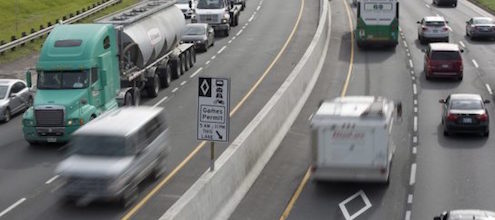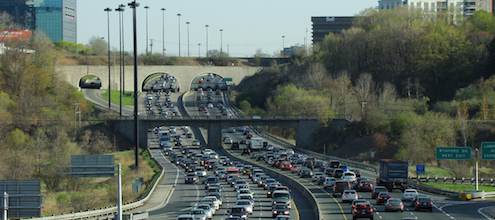
Ontario’s Coming HOT Lane Pilot Project

Late last year, Ontario announced the details of two high-occupancy toll (HOT) lane projects as a means to improve traffic flow in the Greater Toronto Area (GTA). The Province will start by implementing a HOT lane—a hybrid of a tolled road and a high-occupancy vehicle (HOV) lane—as a pilot project on a busy stretch of the Queen Elizabeth Way (QEW) this summer, followed by dedicated HOT lanes on the 427 and 409 a few years later. It’s a significant step forward for congestion pricing in Canada, and a logical policy approach for the GTA.
A big step for the Toronto area, and for Canada
Congestion pricing is a key approach for addressing congestion. In most cities around the world, it is missing across efforts to increase mobility. Congestion pricing policies align the incentives that shape our transportation choices, increasing mobility and reducing gridlock. HOT lanes are a form of congestion pricing that allow low-occupancy vehicles to access HOV (‘carpool’) lanes for a fee.
Given the costs of the Toronto area’s congestion—which could rise to $15 billion per year by 2030—measures to reduce congestion are top of mind for voters, businesses, and policy makers alike.
The GTA’s projects should provide people in the region—and Canadians more broadly—with much needed experience in using HOT lanes. (The GTA’s HOT lane pilot project is slated to be the first try at HOT lanes in Canada.) This should help to improve the public’s understanding of how they work, and serve to inform the design and implementation of any additional HOT lanes in the country.
HOT lanes make sense for the GTA
Multiple hubs of activity, and relatively unconstrained geography in the GTA—compared, for example, with central Montreal’s island boundary—makes converting HOV lanes to HOT lanes (or building new HOT-lane capacity) on the provincially owned 400-series of highways a practical approach for reducing congestion in the area. And, as we also note in our recent report, given the limited experience with congestion pricing in Canada, pilot projects make sense.
HOT lanes can be effective in reducing congestion. For example, in addition to maintaining free-flow speeds on the priced lanes, the MnPASS system introduced in Minnesota increased traffic speeds by 6% in the adjacent general-purpose lanes as well, and increased total throughput by 5% on the HOT lane corridors (while other corridors saw a slight decrease). In response to the system’s success, the State expanded the HOT lane network.
Well-designed HOT lanes help all drivers, not just wealthy ones. Research has shown that people with all levels of income use them. When someone is late to pick up their child at daycare, for example, the benefit may outweigh the cost of the HOT lane, even for low-income parents. And the benefits of HOT lanes are numerous. They make better use of existing road capacity within a network. They give low-occupancy vehicles a reliable option.
Ontario’s HOT lanes will be a great step for Ontario, and important tools to help manage worsening congestion in the GTA. But there are a few specific design issues, which we will look at in our next blog. Stay Tuned.
If you haven’t yet seen our recent report on congestion pricing in Canada, check it out:
Read We Can’t Get There from Here: Why Pricing Congestion is Critical to Beating It
Transport Futures is holding an event in Toronto on HOT Lanes: Friday, January 22nd.




Comments are closed.